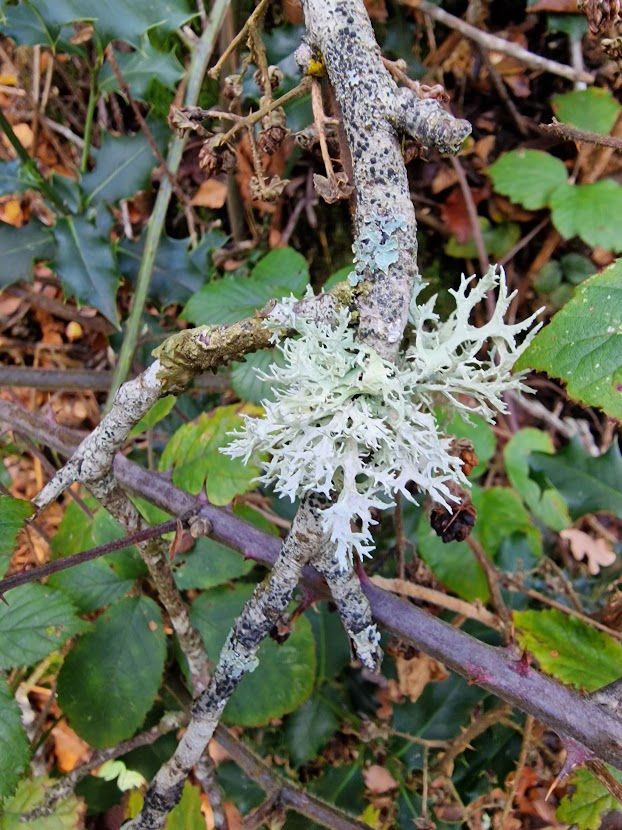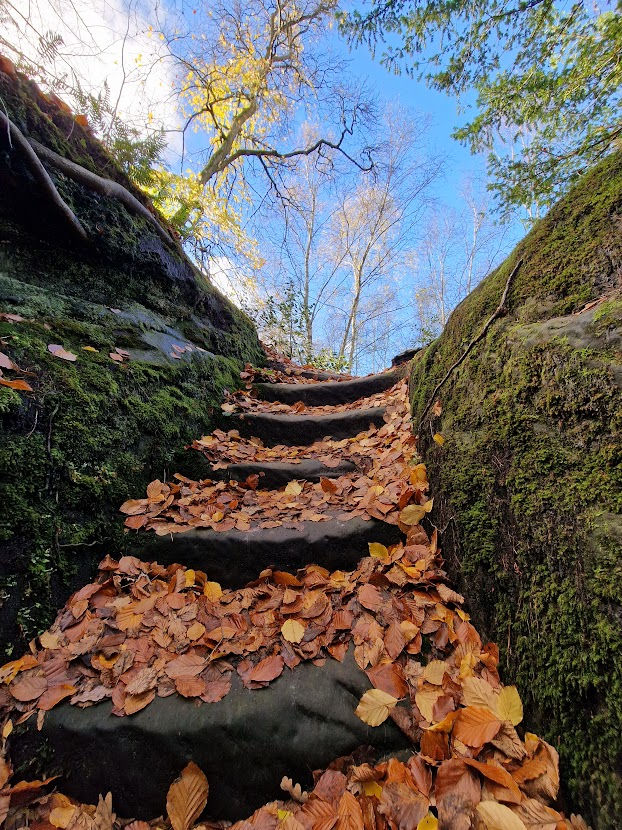Lake Wood, Uckfield. A "Picturesque" landscape. Trees, Rocks, Lichen & Bryophytes. 22.11.22
- Sim Elliott

- Nov 27, 2022
- 7 min read
Updated: Jan 19, 2023
Lake Wood, a Woodlands Trust wood Lake Wood - Visiting Woods - Woodland Trust, is a short walk from the centre of Uckfield. It is an extraordinary landscape; unlike anywhere I have been to in Sussex, although it's Ardingly Sandstone rocks are the same rocks as those of Eridge Rocks. What makes Lake Wood special is the human shaping of the landscape to make a picturesque landscape, including sculpting caves and steps in the rocks, shaping the lake and planting non-native trees. There are many native broadleaf trees in the wood too, and these are the rocks form a habitat for a range of rare ferns, bryophytes, and lichens, which have led to the wood being designated a sight of special interest.
Getting to Lake Wood by public transport from Brighton is relatively easy. The 29 bus goes hourly and take about an hour, see: 29 - Brighton-Tunbridge Wells | Brighton & Hove Buses. Alight at Uckfield High Street, and walk a little way uphill, then turn left (west) into Church Street, which becomes Rocks Road. The entrance to Park Wood is about 1 mile. Warning the last part of the road to the wood has no pavement so extreme care needs to be taken walking in the road.
Different rules for walkers apply when there is no pavement depending on the size of your group. Small groups should keep to the right-hand side of the road so you can see oncoming traffic. Keep close to the side of the road and be prepared to walk in single file. If you come across a sharp right-hand bend it may be safer to cross to the left-hand side of the road and cross back after the bend. Highway Code for walkers - Ramblers
I am quite new to fungi, lichen and bryophyte identification, so some of the tentative identifications in this post may be wrong. Feel free to let me know if I have got an identification wrong! Many fungi, and some mosses and lichens, have more than one common name; I have listed the most common names, separated by forward slashes.
I have not labelled general landscape photos.
I used these resources for identification:
Stefan Buczacki, Chris Shields, Denys W Ovenden (2013) Collins Fungi Guide
Frank S Dobson (2018) Lichens: An illustrated guide to the British and Irish species
Ian Atherton, Sam Bosanquet, Mark Lawley (2019) Mosses and Liverworts of Britian and Ireland; a field guide
I have also used the Obsidentify App Mission - Observation.org
All sections of the text in italics are quartets, sources are cited.
Lake Wood
The entrance, on the north side of Rocks Road

Belonging to the Streatfield family, Lake Wood was part of the Rocks Estate from 1789 until the Woodland Trust acquired the site in 1993. The landed family quickly got to work on adding exotic elements to the tranquil beauty spot. In the early part of the 19th century the southern part of the site was transformed, with the pond being extended into the lake. An array of foreign trees and shrubs were planted in the area, with some that you can still see today. The iconic rock formations were then altered in the latter part of the 19th century. Features were carved out of existing outcrops of sandstone including tunnels and steps, and a boathouse and a sandstone wall were built on the boundary along Rocks Road. Unsurprisingly these changes were made to provide picturesque and romantic walks, with this escapism being just as important today among local residents. There is also a whole host of wildlife to look out for while taking a walk through the Uckfield beauty spot. These include the hazel dormouse, yellow-necked mouse and roe deer. Although the dark forest conditions are always something that will attract bats, the ancient woodland on offer in the area provides a specific incentive for the nocturnal mammals. Lake Wood: The enchanting hidden gem near Uckfield home to some incredible rock formations - SussexLive
The "boat house"

Details of the SSRI citation Rock Wood: 1003127 (naturalengland.org.uk)
Rock Wood is a small ancient woodland lying on Tunbridge Wells sandstone and Wadhurst Clay. A number of different broadleaved woodland types are represented, and there has been some underplanting with conifers. A small stream and its tributary have cut through the sandstone in places creating steep sided ghylls which contain various uncommon Atlantic' bryophytes (mosses and liverworts) and ferns.
The western part of the site is predominantly hornbeam Carpinus betulus coppice, with scattered oak uercus robur standards and some coppiced hazel Corylus avellana.
An ancient bank with hornbeam coppice marks the eastern edge of this type beyond which oak is the dominant tree, with holly llex aquifolium, and coppiced birch Betula spp and hazel. In the south-east beech Fagus sylvatica is co-dominant with oak. Ash Fraxinus excelsior is also present, while coppiced alder woodland occurs along the main stream. In the north spruce Picea sp., Douglas fir Pseudotsuga menziesi, Scots pine PinuS sylvestris have been planted underneath the mixed broadleaved canopy.
Ground flora is sparse under the hornbeam coppice, beech and dense holly while under the oak and hornbeam bramble Rubus fruticosus, ground ivy Glechoma hederacea, wood-sorrel Oxalis acetosella and dog's mercury Mercurialis perennis are found. Wild daffodil Narcissus pseudonarcissus and broad-leaved helleborine Epipactis helleborine are also recorded from Rock Wood.
The ghylls feature a small waterfall which has developed where the smaller stream flows over one of several sandstone outerops occurring throughout the wood. These ghylls have a moist, mild microclimate which is suitable for a number of Atlantic' plant species uncommon in south-east England. These include the mosses Tetraphis browniana and Diphyscium foliosum and the liverwort Marsupella emarginata. Hay-scented buckler fern Dryopteris aemula and Tunbridge filmy fern Hymenophyllum tunbrigense are also present on this site.
The rest of the photographs are in the chorological order of my walk.
A veteran tree.

Probably Yellowing Curtain Crust, Stereum subtomentosum



It is easily confused with Trametes versicolor, the Turkeytail bracket fungus (which differs from Stereum species, however, by having tiny shallow pores on its fertile undersurface), this rather uncommon bracket grows on dead hardwood, and most commonly on Beech. Stereum subtomentosum Yellowing Curtain Crust identification (first-nature.com)

Probably Crystal Brain Exidia nucleata

Red Campion, Silene dioica. Typically blooms, according to the Woodland trust, from April to September; but in bloom in late November

Probably Common Powderhorn or the Powderhorn Cup Lichen, Cladonia coniocraea, probably with Silky Forklet Moss, Dicranella heteromalla

Probably Clustered Bonnet/Oak-Stump Bonnet, Mycena inclinata, a species of mushroom in the family Mycenaceae.



Holly, Ilex aquifolium, I think. Trees can start to grow on bare rock (Arlington Sandstone) as when lichens (a "pioneer" species on rocks) decompose they form enough humus for a tree seed to germinate; see Martin Sheldrake's (2020) Entangled Life.

Lichen (possibly Cladonia species) on roots

Lichen, possibly Fluffy Dust Lichen, Biorhiza pallida


Tunnel under Rock Road

Possibly Mountain Moss Psilocybe, Deconica montana, with possibly Crisped Pincushion Ulota crispa on a log, and its growing on a patch of a Corticiales fungus, the family that includes most of the corticioid (patch- or crust-forming) fungi.


Probably Turkeytail, Trametes versicolor



Typical combination of moss and lichen on the Ardinlgy Sandstone rocks. Moss, possibly Silky Forked Moss, Dicranella heteromalla and Lichen, possibly Fluffy Dust Lichen, Lepraria finkii



Cladonia specieslLichen, possibly, Cladonia fimbriata, the Trumpet Cup Lichen and a Moss species


A Laccaria genus fungus, possibly The Deceiver / Waxy Laccaria, Laccaria laccata or the Scurfy Deceiver, Laccaria proxima




The "Boat House" carved out of the Ardingly Sandstone

A pine and the lake

A pine on a rock

Probably Hairy Curtain Crust fungus, Stereum hirsuitum


Probably Clustered Bonnet / Oak-Stump Bonnet Mycena inclinatus

Candlesnuff/Stag's Horn Fungi, Xylaria hypoxylon with Cypress-leaved Plaitmoss/Hypnum moss, Hypnum cupressiforme



Probably Turkeytail, Tramestes veraicolor

Neat Feathermoss, Pseudoscleropodium purum

A Wood fern.

Common Greenshield lichen, Flavoparmelia caperata

Possibly Peeling Oysterling, Crepidotus mollis

Possibly Yellowing curtain crust, Stereum subomentosusm

Walled Maze Polypore / Blushing Bracket, Daedeleopsis confragosa





Crimped Gill / Crispling, Plicaturopsis crispa


Willow Barkspot, Diatrype bullata, on Birch


The 'Boat House'




Probably Swan's-neck Thyme-moss, Mnium hortum



Probably Cypress-leaved Plaitmoss / Hypnum Moss, Hypnum cupressiforme, the Common Greenshield Lichen, Flavoparmelia caperata, on a tree stump,


Oakmoss Lichen, Evernia prunastri

Tunnel under Rocks Way, for a Ghyll

Bank Haircap, Polytrichastrum formosum, on a tree stump


Possibly powderpuff bracket Postia ptychogaster

Probably Devils' Matchstick Lichen, Cladonia floerkeana


Mock Oyster/Orange Oyster, Phyllotopsis nidulans, on a fallen log of the lake


Probably Yellowing Curtain Crust, Stereum subtomentosum, with possibly the fungus Crstal Brain, Exidia nucleata, or perhaps the Coral slime mold, Ceratiomyxa fruticulosa, in plasmodial form (before fruiting), with probably Cypress-leaved Plait-moss, Hypnum cupressiforme





Probably Devil's Matchstick Lichen, Cladonia floerkeana











Cormorant


Hairy Curtain Crust, Srerum hirsutum

Cladonia sp lichen, and a moss, probably Swan's-neck Leafy Moss, Mnium hornum

Formerly, Common Yellow Russula, latterly Ochre Brittlegill, Russula ochroleuca is a member of the genus Russula, the brittlegills. Common in mixed woodland.


Cladonia sp lichen,

Tree Stump

Steps and "cave" carved to make the landscape more picturesque. I am surprised Park Wood is not more well known. Aside from its SSSI status (for trees, ferns, mosses, liverworts and lichens), it is an outstanding example of the blending of art and nature into a "Picturesque" landscape garden, a distinct taste of the late 18th century and 19th century. It is one of the best examples of picturesque garden design I have seen. The garden was created by the Streatfield family in the 19th century, who extended the mire into a lake, carved features into the rocks and introduced exotic trees.


The taste for wild scenery at home developed later. It was fostered by William Gilpin (1724-1804), the 'Master of the Picturesque and Vicar of Boldre'. Gilpin's great series of Picturesque Tours , published between 1782 and 1809, awakened British tourists to the rugged delights of the River Wye, North Wales and 'the Mountains and Lakes of Cumberland and Westmoreland'. His descriptions of picturesque scenery were followed by three essays which reached to the intellectual heart of eighteenth century garden design theory: landscape painting and the appreciation of nature. They were entitled Three Essays on Picturesque Beauty, on Picturesque Travel and on Sketching Landscape. Gilpin was highly critical of smoothness but loved rough shaggy scenery - both in the wilds and in gardens: "But altho the picturesque traveller is seldom disappointed with pure nature, however rude, yet we cannot deny, but he is often offended with the productions of art....... He is frequently disgusted also, when art aims more at beauty than she ought. How flat, and insipid is often the garden scene, how puerile, and absurd! the banks of the river how smooth, and parallel! the lawn, and its boundaries, how unlike nature!" Picturesque Style of planting design (gardenvisit.com)



Mallards





Possibly Crystal Brain, Exidia nucleata

How I photographed the Crystal Brain. I use an Olympus Tough TG6 camera which has a range of "microscope" (macro) options; here I am using its image stacking option (where images which focus on different parts of the image are blended together). When image stacking you have to use a tripod. I use a Joby flexible tripod because its ideal for responding to woodland terrains


Broom fork-moss, Dicranum scoparium




Lake Wood is mire woodland habitat, an acidic wetland with impeded drainage, including bog pools. This plant is in the middle of the mire - what looks like leaves are actually the reflections of leaves in the water. I couldn't work out what this was at first. But I think it's a Douglas Fir Pseudotsuga menziesi, sapling growing in the bog. There are a couple of introduced Douglas Firs at Lake Wood.


Honeycomb weathering

Common Greenshield Lichen, Flavoparmelia caperata


Rock Wood, from the field to the north of it.




Comments